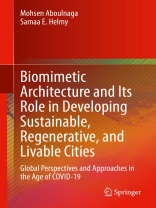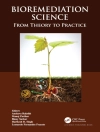This book focuses on understanding biomimetic architecture and its role as a sustainable design tool. It presents the role of biomimicry in mitigation and adaptation to climate change and examines how biomimetic architecture can provide healthy solutions to limit the spread of COVID-19 in buildings and cities. Coverage includes global examples of biomimetic approaches and buildings, an evaluation of the performance of biomimicry applications in architecture to illustrate best practices, and an exploration of how nature can offer inspiration in building design to conserve resources and save energy use as well as curb carbon emissions – a reaffirmed goal of COP 26 and an outcome of Glasgow Climate Pact. Finally, the book presents guidelines to enhance urban areas and healthier spaces in buildings to meet COVID-19 social distance regulations and beyond.
- Examines global applications of biomimicry in architecture;
- Highlights the importance of biomimicry in driving livability in cities and buildings;
- Explores the role of biomimetic architecture in mitigating climate change.
“The line of argument developed is highly relevant to the present, in addition to being original and pertinent to research on urban regeneration, especially in regard to the exploration of the use of biomimicry architecture in response to changing urban demands.”
—Alessandra Battisti, Ph.D., Professor of Architecture, University of Rome La Sapienza-
Tabela de Conteúdo
Introduction.- Biomimicry – Milieu, History, and Approaches.- Biomimicry Influence in Architecture Design.- Biomimicry Role in Climate Change Mitigation and Adaptation.- Global Outlook and Sustainability Applications of Biomimicry in Architecture.- Biomimicry in Criticism.- Biomimicry Innovation and Post COVID-19 Regulations and Suggestions.
Sobre o autor
Prof. Dr. Mohsen Aboulnaga is a Professor of Sustainable Built Environments at the Faculty of Engineering at Cairo University, Egypt. He has more than thirty-five years of experience working in higher education, government, senior management, and consultancy on the issues of sustainable cities, climate change adaptation and mitigation, sustainable development, sustainable energy, and energy policy development. Professor Aboulnaga is a senior expert on sustainable urban development, including green and smart cities, energy efficiency, and green building. His areas of competency encompass strategy planning, policy design, and low-carbon society. Other areas of expertise include executive capacity building for local governments and coaching and training on strategic planning and leadership, Sustainable Development Goals (SDGs), innovation, and urban farming in cities. Professor Aboulnaga has developed many Concept Notes for leading international entities such as ENI ZOHR Sustainability initiative (2019), European Union (EU) funded projects (2018-2019) and Sustainable Urban Development for The Union for the Mediterranean (Uf M) in 2017. He is an associate member of the European Sustainable Development Network (ESDN) Association in Vienna and a Policy Expert of the UNESCO – Inclusive Policy Lab in Paris. Professor Aboulnaga is an author of four books published by Springer and more than 40 chapters in books published by Springer and Elsevier. He has also been invited keynote speaker and speaker to more than 395 international and regional conferences, seminars, workshops, and training programs, and has more than 170 international publications and presentations.
Samaa E. Helmy is trained and qualified as an architect in Egypt. She received a Master’s of Science (M.Sc.) in Architecture – Biomimicry Architecture and a Bachelor’s of Science (B.Sc.) in Architecture from Cairo University, where she is currently registered in the Ph D degree program in the Department of Architecture, Faculty of Engineering. Mrs. Helmy is currently a teaching assistant in the Architectural Engineering and Technology Programme (AET) at Faculty of Engineering at Cairo University and the Department of Architecture at Misr University for Science and Technology (MUST). She completed a 3-week summer school training session on “Sustainability and Energy Conservation in Architecture” at the University of Lincoln in the UK. Additionally, she contributed, with Professor Aboulnaga, to a book ‘Sustainable Ecological Engineering Design’ by a book chapter ‘Future Cities: The Role of Biomimicry Architecture in Improving Livability in Megacities and Mitigating Climate Change Risks’.












